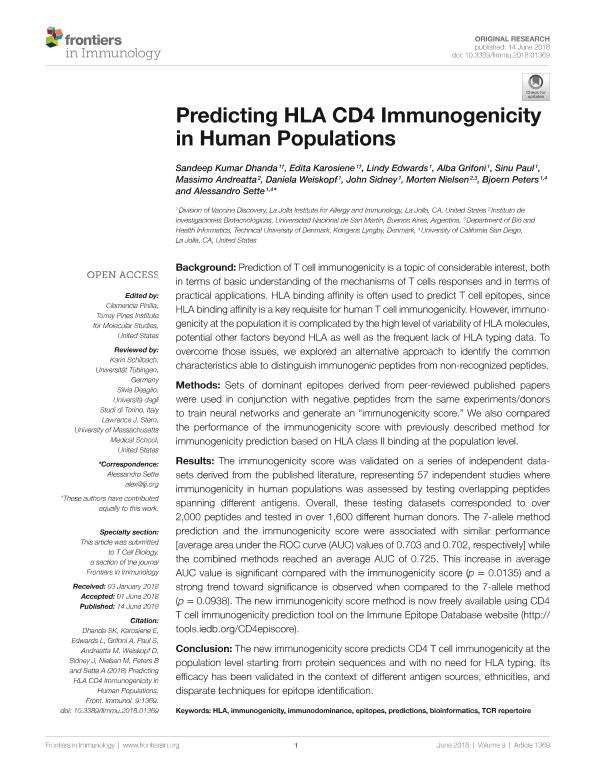Mostrar el registro sencillo del ítem
dc.contributor.author
Dhanda, Sandeep Kumar
dc.contributor.author
Karosiene, Edita
dc.contributor.author
Edwards, Lindy
dc.contributor.author
Grifoni, Alba
dc.contributor.author
Paul, Sinu
dc.contributor.author
Andreatta, Massimo

dc.contributor.author
Weiskopf, Daniela
dc.contributor.author
Sidney, John

dc.contributor.author
Nielsen, Morten

dc.contributor.author
Peters, Bjoern

dc.contributor.author
Sette, Alessandro

dc.date.available
2020-02-10T20:06:20Z
dc.date.issued
2018-06
dc.identifier.citation
Dhanda, Sandeep Kumar; Karosiene, Edita; Edwards, Lindy; Grifoni, Alba; Paul, Sinu; et al.; Predicting HLA CD4 immunogenicity in human populations; Frontiers Media S.A.; Frontiers in Immunology; 9; 6-2018; 1-14
dc.identifier.issn
1664-3224
dc.identifier.uri
http://hdl.handle.net/11336/97108
dc.description.abstract
Background: Prediction of T cell immunogenicity is a topic of considerable interest, both in terms of basic understanding of the mechanisms of T cells responses and in terms of practical applications. HLA binding affinity is often used to predict T cell epitopes, since HLA binding affinity is a key requisite for human T cell immunogenicity. However, immunogenicity at the population it is complicated by the high level of variability of HLA molecules, potential other factors beyond HLA as well as the frequent lack of HLA typing data. To overcome those issues, we explored an alternative approach to identify the common characteristics able to distinguish immunogenic peptides from non-recognized peptides. Methods: Sets of dominant epitopes derived from peer-reviewed published papers were used in conjunction with negative peptides from the same experiments/donors to train neural networks and generate an "immunogenicity score." We also compared the performance of the immunogenicity score with previously described method for immunogenicity prediction based on HLA class II binding at the population level. Results: The immunogenicity score was validated on a series of independent datasets derived from the published literature, representing 57 independent studies where immunogenicity in human populations was assessed by testing overlapping peptides spanning different antigens. Overall, these testing datasets corresponded to over 2,000 peptides and tested in over 1,600 different human donors. The 7-allele method prediction and the immunogenicity score were associated with similar performance [average area under the ROC curve (AUC) values of 0.703 and 0.702, respectively] while the combined methods reached an average AUC of 0.725. This increase in average AUC value is significant compared with the immunogenicity score (p = 0.0135) and a strong trend toward significance is observed when compared to the 7-allele method (p = 0.0938). The new immunogenicity score method is now freely available using CD4 T cell immunogenicity prediction tool on the Immune Epitope Database website (http://tools.iedb.org/CD4episcore). Conclusion: The new immunogenicity score predicts CD4 T cell immunogenicity at the population level starting from protein sequences and with no need for HLA typing. Its efficacy has been validated in the context of different antigen sources, ethnicities, and disparate techniques for epitope identification.
dc.format
application/pdf
dc.language.iso
eng
dc.publisher
Frontiers Media S.A.

dc.rights
info:eu-repo/semantics/openAccess
dc.rights.uri
https://creativecommons.org/licenses/by/2.5/ar/
dc.subject
BIOINFORMATICS
dc.subject
EPITOPES
dc.subject
HLA
dc.subject
IMMUNODOMINANCE
dc.subject
IMMUNOGENICITY
dc.subject
PREDICTIONS
dc.subject
TCR REPERTOIRE
dc.subject.classification
Otras Ciencias de la Salud

dc.subject.classification
Ciencias de la Salud

dc.subject.classification
CIENCIAS MÉDICAS Y DE LA SALUD

dc.title
Predicting HLA CD4 immunogenicity in human populations
dc.type
info:eu-repo/semantics/article
dc.type
info:ar-repo/semantics/artículo
dc.type
info:eu-repo/semantics/publishedVersion
dc.date.updated
2019-11-25T17:42:59Z
dc.journal.volume
9
dc.journal.pagination
1-14
dc.journal.pais
Suiza

dc.journal.ciudad
Lausana
dc.description.fil
Fil: Dhanda, Sandeep Kumar. La Jolla Institute for Allergy and Immunology; Estados Unidos
dc.description.fil
Fil: Karosiene, Edita. La Jolla Institute for Allergy and Immunology; Estados Unidos
dc.description.fil
Fil: Edwards, Lindy. La Jolla Institute for Allergy and Immunology; Estados Unidos
dc.description.fil
Fil: Grifoni, Alba. La Jolla Institute for Allergy and Immunology; Estados Unidos
dc.description.fil
Fil: Paul, Sinu. La Jolla Institute for Allergy and Immunology; Estados Unidos
dc.description.fil
Fil: Andreatta, Massimo. Consejo Nacional de Investigaciones Científicas y Técnicas. Centro Científico Tecnológico Conicet - La Plata. Instituto de Investigaciones Biotecnológicas. Instituto de Investigaciones Biotecnológicas "Dr. Raúl Alfonsín" (sede Chascomús). Universidad Nacional de San Martín. Instituto de Investigaciones Biotecnológicas. Instituto de Investigaciones Biotecnológicas "Dr. Raúl Alfonsín" (sede Chascomús); Argentina
dc.description.fil
Fil: Weiskopf, Daniela. La Jolla Institute for Allergy and Immunology; Estados Unidos
dc.description.fil
Fil: Sidney, John. La Jolla Institute for Allergy and Immunology; Estados Unidos
dc.description.fil
Fil: Nielsen, Morten. Technical University of Denmark; Dinamarca. Consejo Nacional de Investigaciones Científicas y Técnicas. Centro Científico Tecnológico Conicet - La Plata. Instituto de Investigaciones Biotecnológicas. Instituto de Investigaciones Biotecnológicas "Dr. Raúl Alfonsín" (sede Chascomús). Universidad Nacional de San Martín. Instituto de Investigaciones Biotecnológicas. Instituto de Investigaciones Biotecnológicas "Dr. Raúl Alfonsín" (sede Chascomús); Argentina
dc.description.fil
Fil: Peters, Bjoern. University of California at San Diego; Estados Unidos. La Jolla Institute for Allergy and Immunology; Estados Unidos
dc.description.fil
Fil: Sette, Alessandro. University of California at San Diego; Estados Unidos. La Jolla Institute for Allergy and Immunology; Estados Unidos
dc.journal.title
Frontiers in Immunology
dc.relation.alternativeid
info:eu-repo/semantics/altIdentifier/url/https://www.frontiersin.org/article/10.3389/fimmu.2018.01369/full
dc.relation.alternativeid
info:eu-repo/semantics/altIdentifier/doi/http://dx.doi.org/10.3389/fimmu.2018.01369
Archivos asociados
